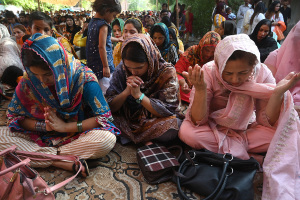Center for Marriage and Family Studies Shows the Benefits of Healthy Marriage
Recently there are many voices heard in opposition to same-sex marriage. Many Christian organizations and family related groups are taking action for maintaining healthy marriage. On Thursday the New Jersey Superior Court and Wisconsin State Legislature refused to legalize same-sex marriage. Christians are paying close attention to the issue of marriage.
Bridget Maher from Family Research Council, who is the Center for Marriage and Family Studies analyst showed the benefits of marriage by statistical evidence and explained the positive impact that healthy marriage has on the society as whole.
How Marriage Benefits Children
· Children living with married parents are much safer than children living with single parents, because they are less likely to be aborted and less likely to be abused or neglected.[1]
· Compared to children in single-parent families, children raised in married-parent homes have better emotional and physical health[2] and engage in fewer risky behaviors, such as premarital sex, substance abuse, delinquency, and suicide.[3]
· Children with married parents do better academically and fare better economically.[4]
· Children raised in intact homes are less likely to cohabit and more likely to view marriage positively and maintain life-long marriages.[5]
How Marriage Benefits Adults
· Married people have better emotional and physical health and live longer than do unmarried people.[6]
· Married couples have greater incomes than do single adults, and the longer they stay married, the more wealth they accumulate.[7]
· Married couples enjoy greater sexual satisfaction than do unmarried people.[8]
· Married women are safer than unmarried women. Never-married, cohabiting, separated, and divorced women experience higher rates of domestic violence than do married women.[9]
How Marriage Benefits Society
· Marriage helps ensure that human life is protected and cherished, since married women are less likely to abort their children than are unmarried women.[10]
· Marriage makes homes safer places to live, because it curbs social problems such as domestic violence and child abuse.[11]
· Communities with more married-parent families are safer and more attractive places to live, because they are less likely to have substance abuse and crime among young people. [12]
· Marriage is the best antidote to poverty and welfare dependency.[13]
· Married people are more likely to be healthy, productive, and engaged citizens, benefiting businesses and, ultimately, the economy.[14]
Reference
1. The Alan Guttmacher Institute, "Trends in Abortion in the United States, 1973-2000," January 2003 and Andrea J. Sedlak and Dinae D. Broadhurst, The Third National Incidence Study of Child Abuse and Neglect, U.S. Department of Health and Human Services, 1996, xviii, 5-19.
2. Kelly J. Kelleher, et al., "Increasing Identification of Psychosocial Problems:1979-1996," Pediatrics 105 (June 2000): 1313-1321 and Deborah A. Dawson, "Family Structure and Children's Health and Well-Being: Data from the 1988 National Health Interview Survey on Child Health," Journal of Marriage and the Family 53 (August 1991): 573-584.
3. John S. Santelli et al., "The Association of Sexual Behaviors with Socioeconomic Status, Family Structure, and Race/Ethnicity Among U.S. Adolescents," American Journal of Public Health 90 (October 2000): 1582-1588; John P. Hoffman and Robert A. Johnson, "A National Portrait of Family Structure and Adolescent Drug Use," Journal of Marriage and the Family 60 (August 1998): 633-645; Patrick J. Darby et al., "Analysis of 112 Juveniles Who Committed Homicide: Characteristics and a Closer Look at Family Abuse," Journal of Family Violence 13 (1998):365-374; Judith Rubenstein et al., "Suicidal Behavior in Adolescents: Stress and Protection in Different Family Contexts," American Journal of Orthopsychiatry 68 (1998): 274-284.
4. Elizabeth Thomson et al., "Family Structure and Child Well-Being: Economic Resources vs. Parental Behaviors," Social Forces 73 (September 1994): 221-242.
5. Paul R. Amato and Danelle D. DeBoer, "The Transmission of Marital Instability Across Generations: Relationship Skills or Commitment to Marriage?" Journal of Marriage and Family 63 (November 2001): 1038-1051; Alfred DeMaris and K. Vaninadha Rao, "Premarital Cohabitation and Subsequent Marital Stability in the United States: A Reassessment," Journal of Marriage and the Family 54 (February 1992): 178-190; Katherine Trent and Scott J. South "Sociodemographic Status, Parental Background, Childhood Family Structure, and Attitudes Toward Family Formation," Journal of Marriage and the Family 54 (May 1992): 427-439.
6. Nadine F. Marks and James D. Lambert, "Marital Status Continuity and Change Among Young and Midlife Adults," Journal of Family Issues 19 (November 1998): 652-686 and Catherine E. Ross et al., "The Impact of the Family on Health: The Decade in Review," Journal of Marriage and the Family 52 (November 1990): 1059-1078.
7. U.S. Census Bureau, Statistical Abstract of the United States: 2001, Table No. 666 and Linda J. Waite and Maggie Gallagher, The Case for Marriage: Why Married People Are Happier, Healthier, and Better Off Financially (New York: Doubleday, 2000) 97-123.
8. Edward O. Laumann et al., The Social Organization of Sexuality: Sexual Practices in the United States (Chicago:University of Chicago Press, 1994) p.364.
9. Sonia Miner Salari and Bret M. Baldwin, "Verbal, Physical, and Injurious Aggression Among Intimate Couples Over Time," Journal of Family Issues 23 (May 2002): 523-550 and Bureau of Justice Statistics, Intimate Partner Violence, National Crime Victimization Survey, May 2000, 4-5, 11.
10. The Alan Guttmacher Institute, "Trends in Abortion in the United States, 1973-2000."
11. Sonia Miner Salari and Bret M. Baldwin, "Verbal, Physical, and Injurious Aggression Among Intimate Couples Over Time" and Andrea J. Sedlak and Dinae D. Broadhurst, The Third National Incidence Study of Child Abuse and Neglect.
12. Terrence P. Thornberry et al., "Family Disruption and Delinquency," Juvenile Justice Bulletin, Office of Juvenile Justice and Delinquency Prevention, U.S. Department of Justice, September 1999.
13. U.S. Census Bureau, "Historical Poverty Tables," Table 4 and June O'Neill and M. Anne Hill, "Gaining Ground? Measuring the Impact of Welfare Reform on Welfare and Work," The Manhattan Institute, Civic Report 17.
14. Corey L.M. Keyes, "The Mental Health Continuum: From Languishing to Flourishing in Life," Journal of Health and Social Behavior 43 (2002): 207-222 as cited in The Family in America New Research, October 2002.




























